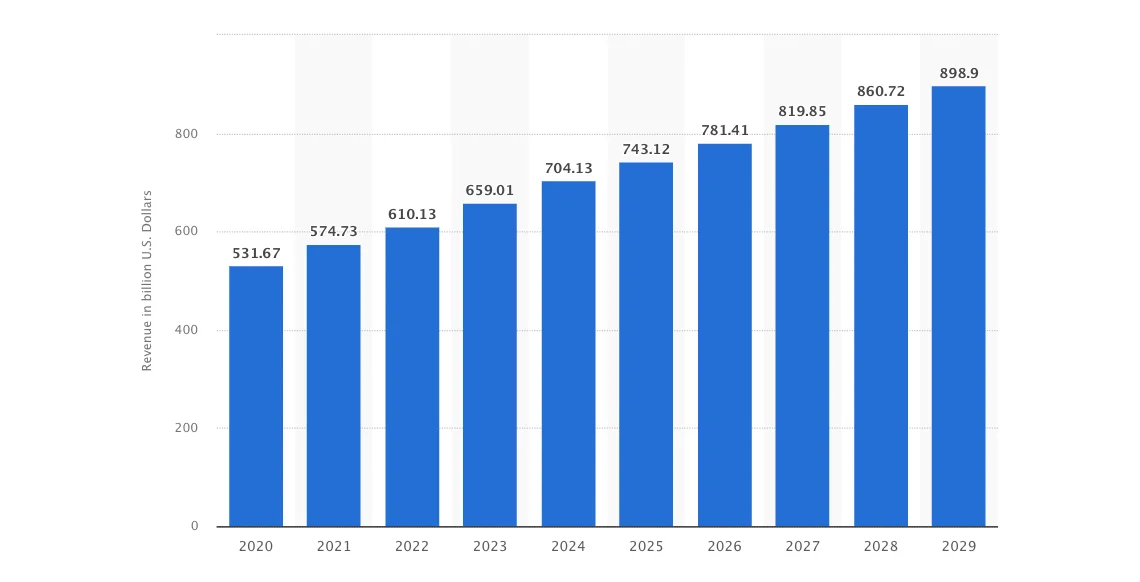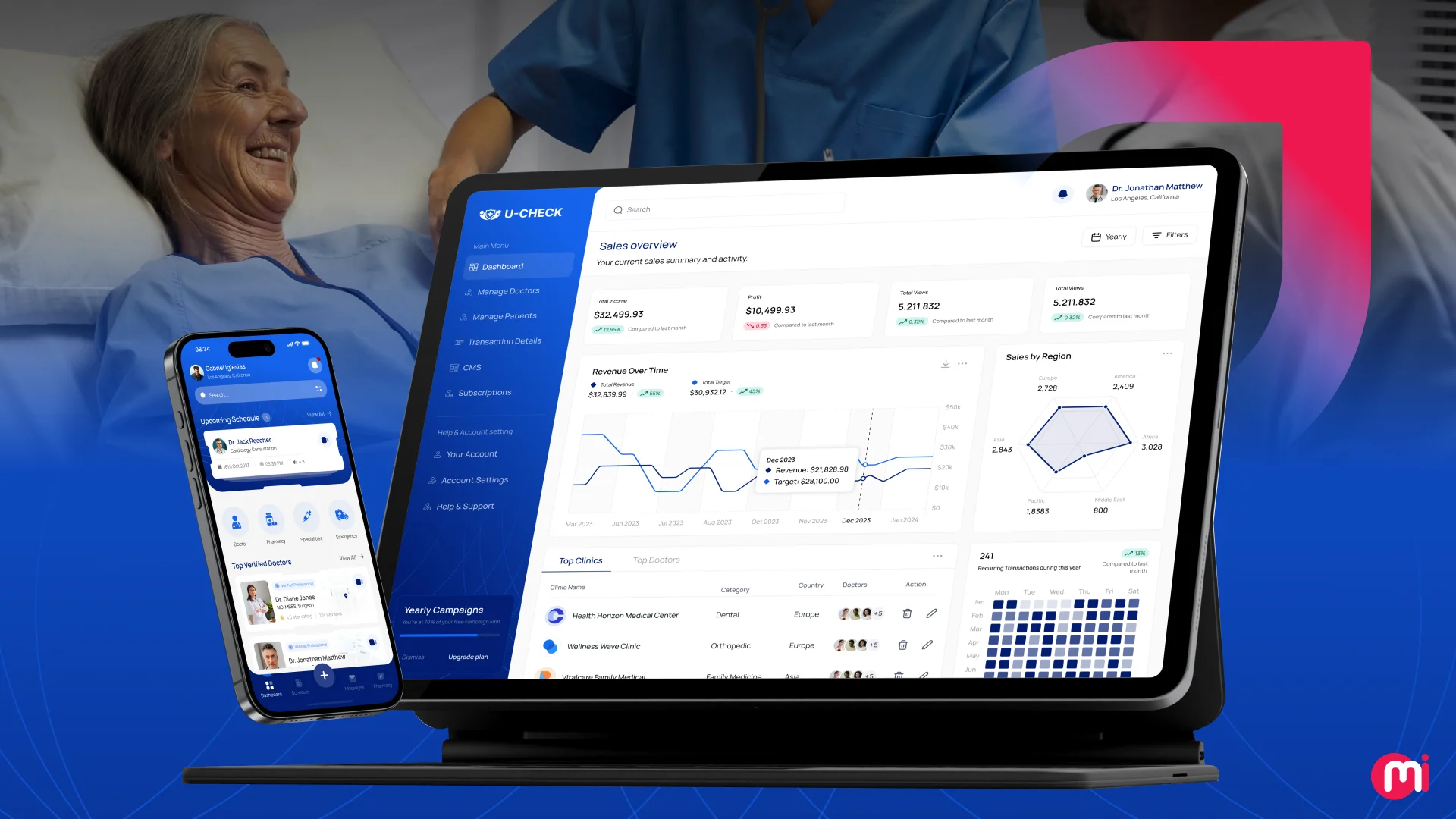101+ Software Development Statistics You Should Know in 2024
- Software
- September 6, 2024
The past few years have been marked by unprecedented challenges for businesses worldwide, including trade wars, natural disasters, and supply chain disruptions. These factors have significantly impacted sectors such as retail, healthcare, and finance, with 36% of businesses identifying geopolitical tensions as a major risk in the Global Risk Survey Q3 2023.
In response to these pressures, a growing number of organizations are turning to technology as a lifeline. In fact, 63% of Forbes Global 2000 CEOs believe that software development and digital innovation are the key to future business success. The rapid evolution of technologies like artificial intelligence, machine learning, and data science can fuel their digital transformation efforts with innovative software development.
To help you navigate this complex landscape, this blog presents essential software development statistics for 2025. By understanding these software development statistics and market trends, you can make informed decisions to go for innovative software solutions that can drive business growth.
Latest Software Development Industry Statistics
- The global IT spending is expected to reach $5 trillion in 2024, marking a nearly 8% increase from 2023.
- The global custom software development market size is expected to rise at a CAGR of 22.5% (2024-2030), with a revenue forecast of $146.18 billion.
- There are over 26.3 million software developers in the world, as per Evans Data Corporation.
- The worldwide shortage of full-time software developers is expected to grow from 1.4 million in 2021 to 4.0 million by 2025, indicating a dramatic increase in demand for skilled professionals.
- The shortage can lead to higher salaries for software developers, with the median salary for a computer programmer in the U.S. being around $130,160 per year and $62.58 per hour.
- Businesses investing in software development have reported 20% growth in revenue on average.
- Typically, a software development project can cost in the range of $15,000 to $100,000 or more, depending on your software idea complexity and various other factors.
- 84.7% of software development projects are for enterprise applications.
- 53.6% of software development projects are mainly for the business automation application.
- 38.5% of software development projects fall into the retail & e-commerce sector-specific category.
Software Development Statistics and Growth Metrics
Do you know how big is the market of software development services? Or What is the size of the software industry market at a global level? Well, this section is all about knowing the current market scenarios of the software development industry and how you can expect it to grow in the upcoming years:
- As per Statista, the global software development market was last valued at around $659.01 billion in 2023 and projected to surpass $898 billion by 2029.
- The global software development industry growth is calculated at a CAGR of 26.67% for the timeline 2024-2029.

- The enterprise software market size is estimated to cross $401.60 billion by 2029 at a CAGR of 6.35% for the tenure 2024-2029.
- The enterprise software market calculates a spend of around $82.91 per employee in 2024.
- Around 64% of outsourced services are related to software application development.
- India is the leading IT outsourcing destination choice of around 80% of US and European firms.
- As per NASSCOM, around 50% of Fortune 500 companies outsource software development projects to Indian IT companies.
- Countries like South Korea, the USA, Germany, Japan, and the UK are the top countries leveraging software solutions and thus considered some of the leading top tech-savvy countries.
Statistics Suggesting Why Should You Go For Business Software Development
In this fast-paced world, having software solutions in place is not just an add-on but a necessity for businesses to thrive in the dense market competition. Software not only helps businesses ease their operations in just a few clicks with utmost transparency but also accelerates revenue generation.
How does software development benefit businesses? And how different businesses have leveraged it. Well, this section covers all necessary software development stats about benefiting businesses:
- As per Deloitte, 36% of businesses already have business process software to automate their business processes and workflows.
- 29% of organizations are in line to build software solutions within 3 years to meet their automation needs.
- Human medical errors are responsible for around 251,454 deaths annually in the U.S., making it a critical area where software solutions can improve accuracy and patient safety.
- As per Gartner’s survey, around 25.56% respondents experienced accelerated growth post-software purchase, while 58.56% of respondents voted for standard growth.
- In 2024, 75% of rapidly growing companies are planning to spend on software in comparison to 2023, which is more than 60% of growth on average.
- Clutch’s 2023 survey revealed that over 83% of companies use custom software in comparison to 2018’s data, which was around 62%.
- Though custom software development can be costly in the start, businesses may realize that in the long run, it can help them save up from recurring licensing renewal fees, leading to cost saving up to 30-50%.
- Around 74% of businesses using CRM have developed stronger customer relationships by offering excellent customer experiences.
- Over 70% of enterprise businesses use ERP software, and from them, more than 53% have claimed that this implementation has helped them experience positive ROI overall.
- As per ValuTrack, around 73% of warehouses are planning to implement mobile inventory management software solutions for effective warehouse management.

Software Development Technology Wise Statistics
Are you wondering which technology is best for software development? Which tech stack is in most demand for software development? Then, you should know that, with time, software development technology evolves and gets replaced by the more promising and competent ones.
Considering the technology evolution and users’ demand for smart, innovative software solutions, the below-mentioned software development technology trends-based statistics can help you in decision-making for choosing the right one:
Cloud Computing Statistics For Software Development
Nowadays, every user wants flexibility in terms of devices, no matter what software they are using. They want their data to be accessible to them with a simple login regardless of the device they access software solutions from. That’s where cloud computing solutions for software development come into play.
- As per Markets and Markets, the global cloud computing market is estimated to surpass 1,266.4 billion by 2028 at a CAGR of 15.1%.
- Gartner estimates that by 2025, over 95% of digital workloads will be deployed on cloud-native platforms, which is considered to be 30% more weightage than in 2021.
- Utilizing cloud computing in software development can improve application development and maintenance productivity by 38%. Applications migrated to the cloud can help to achieve infrastructure cost efficiency by 29%.
- Further, Fortune 500 applications in the cloud have increased their share by 60% from 10%, earning $56 billion in application development and maintenance and $12 billion from IT infrastructure spend.
- The implementation of resilient cloud in software development can reduce downtime by 57% and 26% of cost associated with breaches.
AI/ML and Automation Statistics For Software Development
Data, AI/ML, and Automation are current buzzwords in the industry, from smart electronic gadgets to digital software of all purposes, users want those smart capabilities in their solutions.
Of course, they would be, as data and AI capabilities can offer many perks, which our blog on AI statistics also claims. Also, check below mentioned AI statistics for software development for your better reference:
- Gartner predicts that by 2027, global spending on AI software is estimated to surge to $297.9 billion at a CAGR of 19.1% (with an estimation of 5 years’ tenure).
- In AI software, the inclusion of Generative AI (GenAI) spending can increase by 35% by 2027.
- It is assumed that by 2026, around 70% of independent software vendors (ISVs) will have GenAI implemented in their enterprise software applications.
- Gartner also forecasts the growth of AI software to grow by 20.4% by 2027.
- Spending on generative AI software is projected to increase from 8% of the total AI software market in 2023 to 35% by 2027.
- By 2023, cloud-based Business Process Automation (BPA) software is estimated to reach $41.8 billion at a CAGR of 11.8% – cost-saving and efficiency are the major reasons behind this.
- Around 36% of organizations globally are already using business process management software for workflow automation, and 50% of leaders may have this in their place soon.
- Around 31% of businesses favor automation software as it could benefit them in terms of cost-saving from labor.
Want to implement AI into your software solution? Don’t miss out on AI technology trends, which can offer your business better perks.
Data Analytics and Intelligence Statistics
- Organizations that integrate data analytics and intelligence in their software ecosystem are likely to acquire customers 23X, retain customers 6X, and be 19X more profitable than the ones without it.
- Globally, more than 40% of businesses are leveraging the benefits of big data analytics.
- Leveraging big data can help businesses to get better at making strategic decisions by 69%, achieve optimized operational processes by 54%, get a customer understanding by 52%, and cost efficiency by 47%.
Software Development Stats As Per Development Methodologies and Practices
When it comes to developing software, not just you but many businesses face a dilemma like which methodologies and practices to choose. However, most of them now prefer to go for agile methodologies and DevOps due to obvious reasons.
Many also misunderstand these two as the same one, but they are not, which we also have cleared in our blog – Agile Vs. DevOps, which can help you better understand the difference between the two.
Let’s help you choose the best software development methodology and practice by looking at the statistics for all with their impact:
Statistics About Agile Methodologies for Software Development
- Around 64% of companies have adopted agile methodologies to improve their software delivery and manage changing priorities.
- With the utilization of Agile methodologies in place, around 60% of companies have observed an increase in team productivity and revenue growth.
- 52% of companies with a customer-oriented philosophy have utilized agile methodologies to enhance the quality of their software build.
- 51% of organizations leveraging agile methodologies in software development have experienced enhanced delivery predictability.
- Agile methodologies can also help to improve software development quality, which is even experienced by 45% of companies.
- 42% of businesses that have prioritized agile software development strategy have also experienced savings on development costs to some extent.
- When it comes to choosing software development methodologies, 71% of businesses prefer to choose Agile over the waterfall model.
DevOps Statistics For Software Development
- Globally, 86% of organizations value DevOps as an important factor in their software development approach to achieve competitive advantages.
- As per LogZ data, in software development, 54% of the time, DevOps engineers look after development code observability, monitoring, and security.
- As per Puppet’s survey, more than 80% of organizations are actively practicing DevOps, and this rate will soon reach 94% in the upcoming years.
- A DORA (DevOps Research and Assessment) and a part of Google Cloud reveals that it’s possible for high-performing organizations to achieve commitment to deployment efficiency boost by 2,555 times using DevOps practices.
Software Development Programming Languages-based Statistics
Every business wants to develop an innovative software solution that all categories of target users would like to use. To do so, knowing the leading software development programming language trends is also very important. Hence, here we have gathered leading software development industry statistics as per technology trends, which you must know:
- From its inception to now, even decades later, JavaScript has been the grossing programming language among software developers with a preference of over 63.61%, as per the Stack Overflow Survey.
- In the front end, HTML/CSS is still creating the base for the software applications, being used by 52.97% of developers.
- In the backend and modern-edge software applications, Python is the preference of 49.28% of software engineers.
- In the database query languages, PostgreSQL leads the competition with a preference of over 45.55% of database experts.
- After this, MySQL with 41.09%, SQLite with 30.9%, and MongoDB with a 25.52% developer base, follow the lead of PostgreSQL.
- In the competition of cloud computing platforms, AWS as usual leads the race by being used by 48.62% of cloud engineers, followed by Microsoft Azure with 26.03%, and Google Cloud at 23.86%.
- A year before, in the category of web frameworks, React was leading the way, but in 2023, Node.js took the leap and achieved the preference of 42.65% of developers by surpassing React with the preference of 40.58% of experts. However, there’s no match, as Node.js is solely used for backend application development and React for front-end application development.
Software Developer Demographics and Workforce Trends
- As per Evans Data Corporation report, at the global level, there were around 26.3 million software developers.
- Software developers may surpass 28.7 million count in the upcoming years, mentions Statista survey.
- If we distribute software developers as per gender, around 75% of developers are male and 23% are female software developers.
- If you see, over 61% of software developers use Windows, 45% Unix/Linux, and 46% macOS to develop software applications.
- As per the Stack Overflow Developer Survey, 41.41% of software developers are found working remotely, 42.18% in hybrid situations, and 16.41% in fully office-based work situations.
- It also says that, In the U.S., 69.28% of software developers are employed to work full-time for the companies. On the other hand, only 15.91% of software developers are either working as independent contractors, freelancers, or self-employed, and the rest are either student, unemployed, part-time employed, retired, or not looking for work.
- In Germany, 56.41% of software developers are employed as full-time engineers, and only 10.92% are from the other category, and the rest are the same as for the US.
- In India, 56.02% are full-time employed software developers, and 10.47% fall into the freelancer or self-employed categories and the rest are the same as for the US.
- 59% of software developers working remotely, find themselves more productive than working in other situations like full office-based or hybrid manners.
Software Development Statistics For Different Industries
For each and every industry, software development trends can be different and so does the value. So, if you’re from any of the industries mentioned below, you should know the potential software can have for your industry-specific business and how you can reap the most of the benefits from it. Let’s check out some of the cool software development stats from different industries:
Healthcare Software Development Statistics
- The global telemedicine market was last valued at $130.5 billion and may achieve revenue of $503.8 billion by 2032 at a CAGR of 16.4% for the forecasting period 2024-2032.
- The global Electronics Health Records (EHR) software system market is estimated to grow at a CAGR of 4.43%, with an estimated revenue of $43.36 billion by 2030, which was last estimated at $32.23 billion in 2023.
- With technology evolution and demand for smart medical treatment, the market size of AI in healthcare is expected to grow from $11.7 billion in the software segment to $281.2 billion by 2032 at a CAGR of 39.2% (2024-2032). Plus, the drug discovery software segment reported a market share of 28.1% from it.
- With the increasing popularity and compelling use cases of Generative AI, EY reported 48% of healthcare and Pharma companies are the first to plan their investment in GenAI solutions in 2025.
- Around 90% of clinical drug development faces failure, which can potentially be reduced to a certain extent with the help of AI.
- Not just that, AI can also help the healthcare industry with various practical, doable healthcare software solutions for clinical trial design and monitoring, QA and QC, pharmaceutical product management, drug discovery, pharmaceutical manufacturing, and pharmaceutical product development.
- If AI is a drug discovery software solution, it can help to reduce drug discovery time and costs by 25-50%.
Banking & Finance Software Development Statistics
- The overall Fintech market is projected to get into the list of trillion-dollar industries with an estimation of a $1.5 trillion market cap by 2030.
- Moreover, currently, Fintech holds only 2% of the global financial services revenue of $12.5 trillion. And this percentage stake of fintech in financial services revenue can increase by 7% and 25% in the banking valuation by 2030.
- In the upcoming years, in the category of Fintech solutions, NeoBanks are expected to play a key role in expanding financial access and may contribute to the growing financial market with revenue generation of $364.6 billion by 2026 at a global level with a CAGR of 46.5%.
- In the fintech industry, mobile finance or mobile banking market size is estimated to surpass a valuation of $3.19 billion industry by 2031 at a CAGR of 12.2%, which was last calculated at around $1.13 billion in 2022.
- As per Statista, the global digital payment application users are estimated to surpass the count of 4,805.00m users by 2028. This clearly states the opportunity to invest in developing digital payment applications.
Retail & Ecommerce Software Development Statistics
- As per Statista, the global eCommerce software market revenue is estimated to reach $9.75 billion by 2029 at a CAGR of 3.85% (2024-2029).
- In comparison to that, in the category of Retail and eCommerce software solutions, the U.S. alone encountered a revenue of $4,364 million in 2024.
- Recently, Verified Market Research reported that the revenue of retail management systems software was valued at $2.73 billion and may expand to a CAGR (2024-2031) of 12.06%, with marked revenue growth to $6.8 billion by 2031.
- In the trend of e-commerce solution development, Turkey ranks first globally with a CAGR of 11.58% in the e-commerce development and sales segment, followed by Brazil with 11.56% and India with 11.45%, giving the close competition. This shows that, apart from these, Mexico, Russia, Argentina, Canada, etc., can plan to invest in eCommerce marketplaces to grow their business with such a grossing CAGR rate.
- In the years – 2023 and 2024, retail businesses with AI/ML implementation have witnessed a growth in revenue by 8.1%, and the ones without this have only witnessed a growth of 3.1%.
Supply Chain & Logistics Software Development Statistics
- The global revenue in the supply chain management software market is expected to rise at a CAGR of 4.13%, with a market cap of $24.65 billion by 2029.
- The global logistics software market can reach $22.3 billion by 2032 at a CAGR of 8% for the forecasting period.
- As per McKinsey, around 43% of supply chain businesses have digitized their operations and may expect their annual revenue growth by 2.3%.
- Supply chain businesses with data-oriented software solutions in place can effectively manage their inventory by 20% and productivity by 20-30%.
- With supply chain and logistics, warehouses also need software to manage the inventory effectively. Hence, in link with logistics solutions, the global warehouse management system market can grow to $13.34 billion by 2030 at a CAGR of 19.5% during the forecast period – reported by Grand View Report.
- The adoption of AI in supply chain operations is increasing steadily and may become a critical part of the business, with an expected adoption rate of 38% by 2025.
Statistics About Software Development Challenges
- When it comes to developing a software solution, around 68% of software developers raise concerns about facing unexpected challenges in almost half of the project.
- 49% of software developers say that they face challenges in software development because of the rapid development strategy.
- Sometimes, unclear requirements coming from clients and even passed through the project management team can result in development challenges, as reported by 57% of developers, as per Hutte data.
- The major reason behind the delay in software time-to-market is last-minute changes; this has happened in around 55% of projects, as per Hutte data.
- The same data also covers that, remote work arrangements even result in collaboration issues, as reported by 50% of software development teams.
- And 52% of associates also find it difficult to choose the right-fit technology and tools that go seamlessly with the software idea.
- Moreover, 13% of businesses find it challenging to hire software developers – the best fit to meet their objective-specific requirements.
Software Development Stats: Future Possibilities
- As per Statista, the revenue of the enterprise software market is estimated to reach 344.4 billion, application development software to 217 billion, system infrastructure software to 156.4 billion, and productivity software to 88.44 billion by 2027.
- The global AI software development market size is expected to reach 1094.52 billion by 2032 at a CAGR of 22.97%.
- From $41 billion in 2023 to $287.4 billion by 2033, the global market size of spending on Generative AI in software development is about to grow at a CAGR of 21.5%.
In Conclusion
The landscape of software development is constantly evolving, driven by rapid advancements in technology, shifting market demands, and the ever-increasing expectations of users. The statistics highlighted in this blog provide a clear picture of current trends, challenges, and opportunities within the industry.
Whether it’s the rise of AI and machine learning, the growing importance of cybersecurity, or the need for agile and scalable solutions, businesses must stay informed and adaptable to thrive in this technology driven competitive environment.
FAQs About Software Development Statistics
At the latest, there are over 4.4 million software developers in the United States.
As per the latest research, only 29% of software development developers find success, 52% of them get challenged, and 19% of the remaining ones end up as failures. Reasons like unclear requirements, poor project management, not choosing the right development skill, poor budget allocation, and many others result in software development failure.
Yes, all thanks to the availability of the world’s first AI software engineer – Devin – an advanced GenAI model that works by analyzing human speech and behavior patterns, software development can be automated. Not the entire software development can be automated to the full extent, but as per our founding, around 70-85% of functional software testing can be automated.
Well, it’s highly unlikely that AI will replace software engineers, but can become an accelerator of growth that can guarantee accuracy and precision.













